The global liquid desiccant natural gas dehydration unit market is valued at USD 923.5 million in 2025. It is slated to reach USD 1,685.4 million by 2035, recording an absolute increase of USD 761.9 million over the forecast period. This translates into a total growth of 82.5%, with the liquid desiccant natural gas dehydration unit market forecast to expand at a compound annual growth rate (CAGR) of 6.2% between 2025 and 2035. The overall market size is expected to grow by nearly 1.83X during the same period, supported by increasing demand for natural gas processing infrastructure, growing adoption of glycol dehydration systems in upstream and midstream operations, and rising emphasis on moisture removal and pipeline quality specifications across diverse natural gas production, processing facilities, and transmission applications.
Between 2025 and 2030, the liquid desiccant natural gas dehydration unit market is projected to expand from USD 923.5 million to USD 1,174.8 million, resulting in a value increase of USD 251.3 million, which represents 33.0% of the total forecast growth for the decade. This phase of development will be shaped by increasing natural gas production from conventional and unconventional reserves, rising LNG export infrastructure development and gas processing capacity additions, and growing demand for efficient moisture removal systems ensuring pipeline corrosion prevention and hydrocarbon dewpoint control. Energy companies and gas processors are expanding their dehydration capabilities to address the growing demand for reliable and cost-effective water removal solutions that ensure gas quality specifications and operational integrity.
From 2030 to 2035, the liquid desiccant natural gas dehydration unit market is forecast to grow from USD 1,174.8 million to USD 1,685.4 million, adding another USD 510.6 million, which constitutes 67% of the overall ten-year expansion. This period is expected to be characterized by the expansion of offshore gas field development and deepwater production facilities, the development of modular and compact dehydration systems for remote locations, and the growth of specialized applications for sour gas processing, high-pressure operations, and Arctic environments. The growing adoption of automation technologies and digital monitoring systems will drive demand for liquid desiccant dehydration units with enhanced operational efficiency and remote management capabilities.
Between 2020 and 2025, the liquid desiccant natural gas dehydration unit market experienced steady growth, driven by expanding natural gas infrastructure investments and growing recognition of glycol dehydration technology as essential processing equipment for meeting pipeline specifications and preventing operational issues in diverse upstream production, gas gathering, and transmission applications. The liquid desiccant natural gas dehydration unit market developed as oil & gas operators and midstream companies recognized the potential for liquid desiccant systems to provide reliable moisture removal, support corrosion prevention, and ensure gas quality compliance while meeting stringent operational requirements. Technological advancement in glycol regeneration and automation systems began emphasizing the critical importance of maintaining system efficiency and minimizing glycol losses in challenging processing environments.
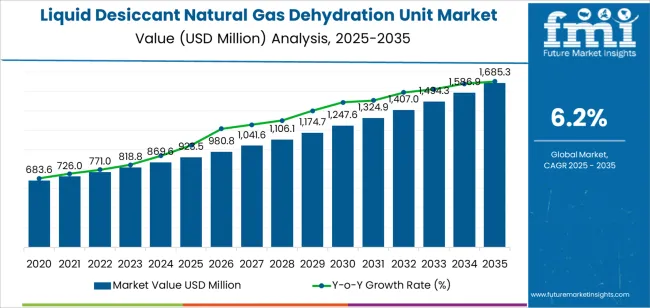
| Metric | Value |
|---|---|
| Estimated Value in (2025E) | USD 923.5 million |
| Forecast Value in (2035F) | USD 1,685.4 million |
| Forecast CAGR (2025 to 2035) | 6.2% |
Market expansion is being supported by the increasing global demand for natural gas processing infrastructure driven by rising natural gas production, LNG export growth, and pipeline network expansion, alongside the corresponding need for reliable moisture removal systems that can prevent pipeline corrosion, ensure gas quality specifications, and maintain operational efficiency across various upstream production, midstream processing, gas gathering, and transmission applications. Modern oil & gas operators and midstream companies are increasingly focused on implementing liquid desiccant dehydration solutions that can improve gas quality, prevent hydrate formation, and provide consistent performance in demanding field conditions.
The growing emphasis on operational reliability and asset integrity is driving demand for liquid desiccant dehydration units that can support corrosion prevention, enable hydrocarbon dewpoint control, and ensure comprehensive gas conditioning. Energy companies' preference for dehydration systems that combine processing efficiency with operational simplicity and maintenance accessibility is creating opportunities for innovative liquid desiccant implementations. The rising influence of remote operations and digitalization is also contributing to increased adoption of dehydration units that can provide automated control without compromising reliability or processing effectiveness.
The liquid desiccant natural gas dehydration unit market is segmented by glycol type, application, and region. By glycol type, the market is divided into diethylene glycol (DEG) dehydration unit, monoethylene glycol (MEG) dehydration unit, triethylene glycol (TEG) dehydration unit, tetraethylene glycol (TREG) dehydration unit, and others. Based on application, the liquid desiccant natural gas dehydration unit market is categorized into onshore oil and gas, offshore oil and gas, and other. Regionally, the liquid desiccant natural gas dehydration unit market is divided into East Asia, Europe, North America, South Asia, Latin America, Middle East & Africa, and Eastern Europe.
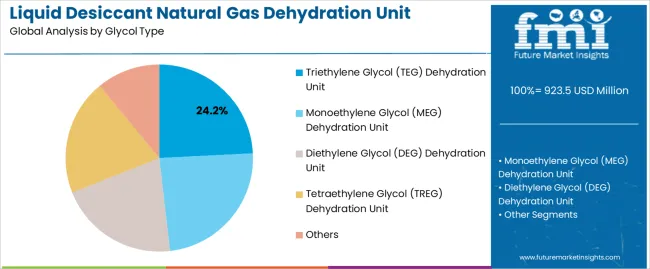
The triethylene glycol (TEG) dehydration unit segment is projected to maintain its leading position with 24.2% market share in the liquid desiccant natural gas dehydration unit market in 2025, reaffirming its role as the preferred glycol type for natural gas moisture removal and industry-standard dehydration applications. Oil & gas operators increasingly utilize TEG dehydration systems for their optimal balance of dehydration efficiency, proven operational reliability, and established effectiveness in achieving pipeline specifications while minimizing operating costs and maintenance requirements. TEG technology's proven effectiveness and industry acceptance directly address operational requirements for cost-effective moisture removal and reliable gas conditioning across diverse production environments and processing scales.
This glycol type segment forms the foundation of natural gas dehydration operations, as it represents the technology with the greatest industry adoption and established performance record across multiple field applications and operational configurations. Oil & gas industry investments in gas processing infrastructure continue to strengthen TEG adoption among producers and midstream operators. With operational pressures requiring reliable dehydration and cost-effective processing, TEG dehydration units align with both technical objectives and economic requirements, making it the central component of comprehensive gas conditioning strategies.
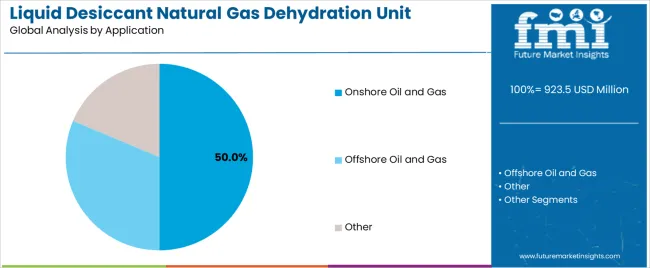
The onshore oil and gas application segment is projected to represent 50% market share of liquid desiccant dehydration unit demand in 2025, underscoring its critical role as the primary driver for dehydration system adoption across conventional gas fields, unconventional shale plays, gas gathering networks, and onshore processing facilities. Onshore operators prefer liquid desiccant dehydration for gas conditioning due to proven technology reliability, straightforward installation and maintenance, and ability to meet pipeline specifications while supporting field development economics and operational flexibility. Positioned as essential equipment for onshore gas processing, liquid desiccant units offer both technical advantages and economic benefits.
The segment is supported by continuous expansion of onshore gas production and the growing development of unconventional gas resources that require comprehensive gas conditioning with moisture removal and quality assurance. Additionally, onshore operators are investing in dehydration infrastructure to support increasingly stringent pipeline specifications and demand for corrosion-free gas transmission. As onshore gas production expands and infrastructure development continues, the onshore oil and gas application will continue to dominate the liquid desiccant natural gas dehydration unit market while supporting accessible gas processing and reliable moisture removal strategies.
The liquid desiccant natural gas dehydration unit market is advancing steadily due to increasing demand for natural gas processing infrastructure driven by rising gas production, expanding LNG facilities, and growing pipeline networks requiring specialized moisture removal technologies providing enhanced operational characteristics and reliability benefits across diverse upstream production, midstream processing, gas gathering, and transmission applications. However, the liquid desiccant natural gas dehydration unit market faces challenges, including environmental concerns regarding glycol emissions and disposal, operational complexity related to glycol regeneration and contamination management, and competition from alternative dehydration technologies including solid desiccant and membrane systems. Innovation in emission control technologies and automated monitoring systems continues to influence product development and market expansion patterns.
The growing global natural gas production from conventional and unconventional reserves combined with expanding LNG export terminal development is driving substantial investment in gas processing infrastructure including comprehensive dehydration systems preventing pipeline corrosion and ensuring export specifications. Modern gas processing facilities require reliable dehydration technology capable of handling varying gas compositions and production rates while maintaining consistent moisture removal performance. Energy companies are increasingly recognizing the competitive advantages of efficient liquid desiccant systems for optimizing gas quality and supporting downstream infrastructure protection, creating opportunities for advanced dehydration designs with enhanced capacity and improved glycol management specifically engineered for large-scale processing operations.
Modern liquid desiccant dehydration unit manufacturers are incorporating automated control systems, digital monitoring platforms, and predictive maintenance capabilities to enhance operational efficiency, reduce manual intervention, and support comprehensive process optimization through real-time performance data and remote diagnostics. Leading companies are developing smart dehydration systems, implementing IoT sensor integration, and advancing control algorithms that optimize glycol circulation, minimize losses, and predict maintenance requirements. These technologies improve operational reliability while enabling new service opportunities, including remote monitoring services, performance optimization consulting, and condition-based maintenance programs. Advanced digitalization integration also allows operators to support comprehensive operational efficiency objectives and cost reduction beyond traditional manual operation approaches.
The expansion of remote field development, offshore platform space constraints, and distributed gas production is driving demand for compact and modular liquid desiccant dehydration units with reduced footprint, simplified installation, and pre-engineered configurations. These specialized designs address space limitations while maintaining processing capability, creating differentiated value propositions for challenging installation environments and rapid deployment requirements. Manufacturers are investing in compact engineering and modular fabrication to serve demanding space-constrained applications while supporting installation flexibility and capital cost optimization across remote and offshore project developments.
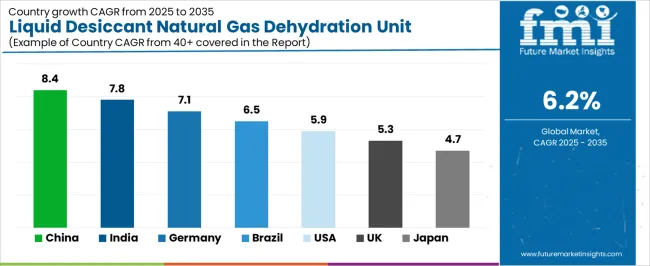
| Country | CAGR (2025-2035) |
|---|---|
| China | 8.4% |
| India | 7.8% |
| Germany | 7.1% |
| Brazil | 6.5% |
| United States | 5.9% |
| United Kingdom | 5.3% |
| Japan | 4.7% |
The liquid desiccant natural gas dehydration unit market is experiencing solid growth globally, with China leading at an 8.4% CAGR through 2035, driven by expanding natural gas infrastructure development, increasing gas import capacity, and growing domestic gas production supporting energy transition objectives. India follows at 7.8%, supported by ambitious gas infrastructure expansion, growing LNG import terminals, and increasing gas distribution network development. Germany shows growth at 7.1%, emphasizing natural gas infrastructure, import terminal development, and industrial gas processing requirements. Brazil demonstrates 6.5% growth, supported by pre-salt gas production, expanding midstream infrastructure, and growing gas processing capacity. The United States records 5.9%, focusing on shale gas production, midstream expansion, and LNG export infrastructure. The United Kingdom exhibits 5.3% growth, emphasizing offshore gas production and import infrastructure. Japan shows 4.7% growth, focusing on LNG import facilities and gas processing requirements.
The report covers an in-depth analysis of 40+ countries top-performing countries are highlighted below.
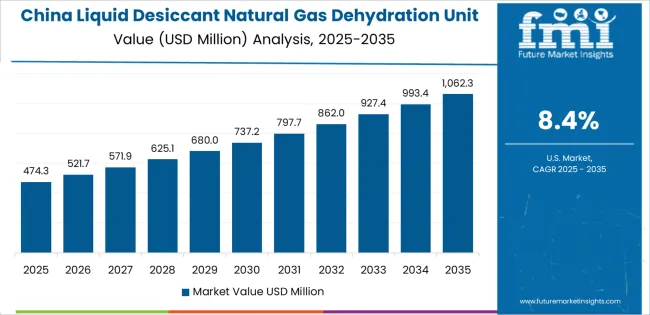
Revenue from liquid desiccant natural gas dehydration units in China is projected to exhibit exceptional growth with a CAGR of 8.4% through 2035, driven by massive natural gas infrastructure development programs and expanding domestic gas production supported by government initiatives promoting cleaner energy adoption and reduced coal dependence. The country's comprehensive gas network expansion and increasing LNG import capacity are creating substantial demand for dehydration solutions. Major energy companies and equipment manufacturers are establishing comprehensive production and service capabilities to serve both domestic markets and regional export opportunities.
Revenue from liquid desiccant natural gas dehydration units in India is expanding at a CAGR of 7.8%, supported by ambitious natural gas infrastructure expansion programs, growing LNG import capacity, and increasing gas distribution network development addressing energy security and clean fuel objectives. The country's comprehensive gas sector development and increasing investment in midstream infrastructure are driving sophisticated dehydration equipment demand throughout production and processing facilities. Leading energy companies and equipment suppliers are establishing service networks to address growing infrastructure requirements.
Revenue from liquid desiccant natural gas dehydration units in Germany is expanding at a CAGR of 7.1%, supported by the country's comprehensive natural gas infrastructure, LNG import terminal development, and industrial gas processing requirements emphasizing operational reliability and environmental compliance. The nation's technological sophistication and quality standards are driving premium dehydration equipment capabilities throughout gas processing applications. Leading engineering companies and equipment manufacturers are investing extensively in advanced dehydration technologies and service capabilities.
Revenue from liquid desiccant natural gas dehydration units in Brazil is expanding at a CAGR of 6.5%, driven by extensive pre-salt oil and gas production generating associated gas requiring processing, expanding midstream infrastructure connecting production to markets, and growing gas utilization replacing liquid fuels. Brazil's resource development activities and infrastructure investment are supporting demand for gas processing equipment. Energy companies and service providers are establishing comprehensive capabilities for dehydration system deployment.
Revenue from liquid desiccant natural gas dehydration units in the United States is expanding at a CAGR of 5.9%, supported by the country's extensive shale gas production, established midstream infrastructure, and growing LNG export capacity driving gas processing equipment demand. The nation's comprehensive natural gas sector and technological leadership are driving sophisticated dehydration system applications. Energy companies and equipment manufacturers are investing in technology advancement and capacity expansion to serve diverse market segments.
Revenue from liquid desiccant natural gas dehydration units in the United Kingdom is growing at a CAGR of 5.3%, driven by the country's offshore gas production, LNG import terminal operations, and gas processing requirements supporting energy security and industrial demand. The United Kingdom's mature energy sector and offshore expertise are supporting investment in reliable dehydration equipment. Energy operators and service companies are establishing comprehensive gas processing capabilities incorporating advanced dehydration systems.
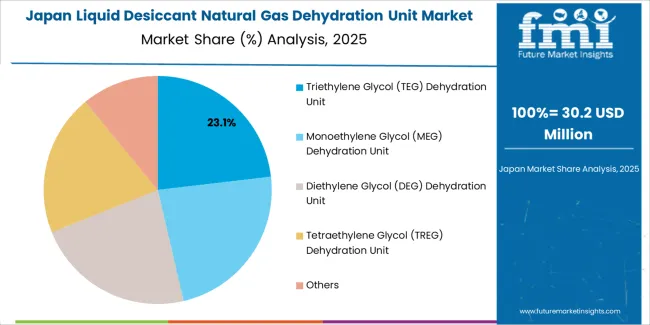
Revenue from liquid desiccant natural gas dehydration units in Japan is expanding at a CAGR of 4.7%, supported by the country's extensive LNG import infrastructure, industrial gas processing requirements, and quality standards requiring reliable gas conditioning equipment. Japan's technological sophistication and quality consciousness are driving demand for premium dehydration systems. Energy companies and industrial operators are investing in high-specification dehydration equipment for critical applications.
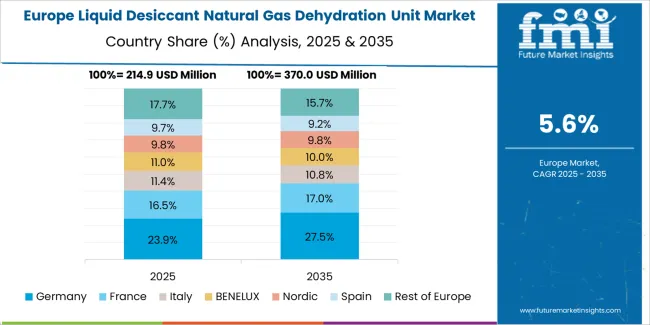
The liquid desiccant natural gas dehydration unit market in Europe is projected to grow from USD 238.4 million in 2025 to USD 424.8 million by 2035, registering a CAGR of 5.9% over the forecast period. Germany is expected to maintain leadership with a 26.4% market share in 2025, moderating to 26.1% by 2035, supported by comprehensive gas infrastructure, LNG import development, and industrial processing requirements.
The United Kingdom follows with 18.6% in 2025, projected at 18.4% by 2035, driven by offshore gas production, LNG import terminals, and gas processing infrastructure. France holds 15.8% in 2025, rising to 16.0% by 2035 on the back of gas infrastructure development and import capacity expansion. Italy commands 13.2% in 2025, reaching 13.4% by 2035, while Spain accounts for 10.4% in 2025, rising to 10.6% by 2035 aided by LNG import growth and gas network expansion. The Netherlands maintains 7.8% in 2025, up to 8.0% by 2035 due to gas trading hub operations and processing facilities. The Rest of Europe region, including Nordics, Central & Eastern Europe, and other markets, is anticipated to hold 7.8% in 2025 and 7.5% by 2035, reflecting development in gas infrastructure and processing capacity expansion.
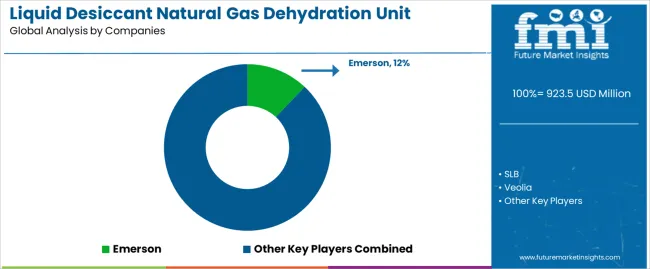
The liquid desiccant natural gas dehydration unit market is characterized by competition among specialized gas processing equipment manufacturers, integrated energy services companies, and industrial engineering firms. Companies are investing in system efficiency optimization, automation technology integration, compact design development, and emission reduction solutions to deliver reliable, efficient, and environmentally responsible dehydration systems. Innovation in glycol regeneration technologies, digital monitoring platforms, and modular system designs is central to strengthening market position and competitive advantage.
Emerson offers comprehensive process automation and dehydration system solutions with focus on operational efficiency, digital integration, and reliability optimization. SLB provides integrated oilfield services including gas processing equipment with emphasis on field-proven technologies and global service capabilities. Veolia delivers industrial water and gas treatment solutions with focus on environmental performance and operational efficiency. CECO offers environmental technologies including gas processing systems with emphasis on emission control and compliance. Pietro Fiorentini provides gas measurement and processing equipment with focus on European markets and quality engineering. Nihon Seiki specializes in Asian market gas processing solutions. VOGELBUSCH Biocommodities (Vogelbusch Group) offers specialized gas processing technologies. Generon provides gas separation and dehydration systems. ALCO Inc. delivers gas processing equipment for diverse applications. STI focuses on specialized treatment technologies. Vogelbusch Group provides comprehensive process technologies. REPCo Srl offers Italian-engineered gas processing solutions. LUDY Petrochemical Equipment (Jiangsu) supplies Chinese market processing equipment.
Liquid desiccant natural gas dehydration units represent a critical gas processing equipment segment within oil & gas and energy infrastructure applications, projected to grow from USD 923.5 million in 2025 to USD 1,685.4 million by 2035 at a 6.2% CAGR. These essential gas conditioning systems—primarily glycol-based dehydration configurations—serve as vital processing equipment in natural gas production, pipeline transmission, LNG facilities, and gas storage operations where moisture removal, corrosion prevention, and gas quality assurance are essential. Market expansion is driven by increasing natural gas production, growing LNG infrastructure development, expanding pipeline networks, and rising demand for reliable gas conditioning across diverse upstream, midstream, and downstream segments.
How Energy Regulators Could Strengthen Standards and Environmental Protection?
How Industry Associations Could Advance Technology Standards and Best Practices?
How Dehydration Unit Manufacturers Could Drive Innovation and Market Leadership?
How Energy Operators Could Optimize System Performance and Reliability?
How Research Institutions Could Enable Technology Advancement?
How Investors and Financial Enablers Could Support Market Growth and Innovation?
| Items | Values |
|---|---|
| Quantitative Units (2025) | USD 923.5 million |
| Glycol Type | Diethylene Glycol (DEG) Dehydration Unit, Monoethylene Glycol (MEG) Dehydration Unit, Triethylene Glycol (TEG) Dehydration Unit, Tetraethylene Glycol (TREG) Dehydration Unit, Others |
| Application | Onshore Oil and Gas, Offshore Oil and Gas, Other |
| Regions Covered | East Asia, Europe, North America, South Asia, Latin America, Middle East & Africa, Eastern Europe |
| Countries Covered | China, India, Germany, Brazil, United States, United Kingdom, Japan, and 40+ countries |
| Key Companies Profiled | Emerson, SLB, Veolia, CECO, Pietro Fiorentini |
| Additional Attributes | Dollar sales by glycol type and application categories, regional demand trends, competitive landscape, technological advancements in glycol dehydration, emission control development, automation integration, and operational efficiency optimization |
The global liquid desiccant natural gas dehydration unit market is estimated to be valued at USD 923.5 million in 2025.
The market size for the liquid desiccant natural gas dehydration unit market is projected to reach USD 1,685.3 million by 2035.
The liquid desiccant natural gas dehydration unit market is expected to grow at a 6.2% CAGR between 2025 and 2035.
The key product types in liquid desiccant natural gas dehydration unit market are triethylene glycol (teg) dehydration unit, monoethylene glycol (meg) dehydration unit, diethylene glycol (deg) dehydration unit, tetraethylene glycol (treg) dehydration unit and others.
In terms of application, onshore oil and gas segment to command 50.0% share in the liquid desiccant natural gas dehydration unit market in 2025.






Full Research Suite comprises of:
Market outlook & trends analysis
Interviews & case studies
Strategic recommendations
Vendor profiles & capabilities analysis
5-year forecasts
8 regions and 60+ country-level data splits
Market segment data splits
12 months of continuous data updates
DELIVERED AS:
PDF EXCEL ONLINE
Liquid Carton Packaging Market Size and Share Forecast Outlook 2025 to 2035
Liquid Filled Pressure Gauges Market Size and Share Forecast Outlook 2025 to 2035
Liquid Filtration Market Size and Share Forecast Outlook 2025 to 2035
Liquid Packaging Board Market Size and Share Forecast Outlook 2025 to 2035
Liquid Filled Capsule Market Size and Share Forecast Outlook 2025 to 2035
Liquid Density Meters Market Size and Share Forecast Outlook 2025 to 2035
Liquid Cold Plates Market Size and Share Forecast Outlook 2025 to 2035
Liquid Crystal Polymers Market Size and Share Forecast Outlook 2025 to 2035
Liquid Embolic Agent Market Size and Share Forecast Outlook 2025 to 2035
Liquid Hydrogen Market Size and Share Forecast Outlook 2025 to 2035
Liquid Cooled Home Standby Gensets Market Size and Share Forecast Outlook 2025 to 2035
Liquid Nitrogen Purge Systems Market Size and Share Forecast Outlook 2025 to 2035
Liquid Chromatography Systems Market Size and Share Forecast Outlook 2025 to 2035
Liquid Armor Materials Market Size and Share Forecast Outlook 2025 to 2035
Liquid Synthetic Rubber Market Size and Share Forecast Outlook 2025 to 2035
Liquid Crystal Polymer (LCP) Market Size and Share Forecast Outlook 2025 to 2035
Liquid Smoke Market Analysis - Size, Share, and Forecast Outlook 2025 to 2035
Liquid-Tight Flexible Non-Metallic Conduit Market Size and Share Forecast Outlook 2025 to 2035
Liquid Hand Soap Market Size and Share Forecast Outlook 2025 to 2035
Liquid Packaging Market Size and Share Forecast Outlook 2025 to 2035

Thank you!
You will receive an email from our Business Development Manager. Please be sure to check your SPAM/JUNK folder too.
Chat With
MaRIA